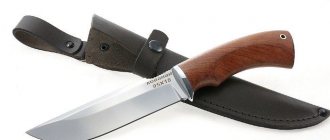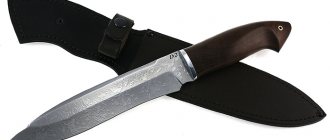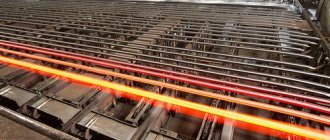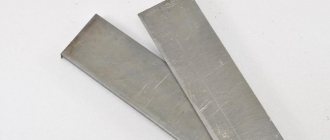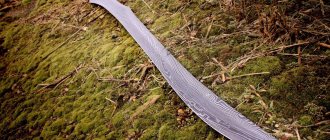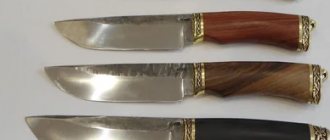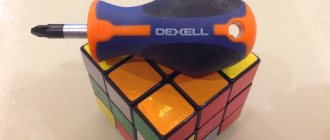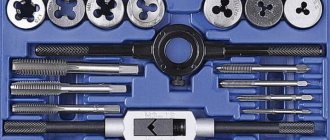Knives are a must-have accessory for any kitchen. But their range of applications is not limited to home use. They will come in handy when hunting, hiking, or fishing.
Steel 95Х18 and Х12МФ are considered one of the best materials for the manufacture of cutting tools. Each of them has its own advantages and disadvantages, so when choosing to understand which knife is better, X12MF or 95X18, it’s a good idea to know the features of each steel grade so as not to be disappointed in your expectations.
Rating of knife steels
For convenience, in the TOP steels and alloys for the manufacture of fixed-type knife blades, they are presented in order of increasing characteristics and prices, respectively.
9ХС
High carbon steel is present at the bottom of the rating due to the fact that it is a sales leader. Knives of the budget category with a decent cut and an edge that doesn’t dull for a long time. 9ХС steel is very difficult to forge; if the temperature conditions are violated, the edge will crack. But, after proper forging, the edge is able to withstand light impact loads. For example, you can use a knife to chop branches for a fire.
Inexpensive high-speed steel was originally developed for the mass production of drills. This carbon became a knife material much later.
95Х18
Domestic forged stainless steel, completely maintenance-free, usually with a glossy, shiny polished mirror surface. Steel belongs to the budget category and is available to a wide range of consumers. It cuts somewhat worse and dulls much faster compared to high-carbon steels. It is not afraid of shock loads, but has low fracture strength.
Steel 95X18 can be hardened to a cutting edge strength of 58 HRC. The first sharpening is carried out at the factory, after which the knife can be easily straightened and sharpened at home without special tools. Food acids and high temperatures in household ovens cannot corrode stainless steel.
Blades made of steel 95X18 are used in fishing, tourist, chef, cutting, fillet, souvenir, and gift knives. Hunters with licenses for large game - elk, wild boar - rarely use it. Aggressive cutting is impossible in principle here. Professionals believe that stainless steel “irones” and does not cut. The sharpening is not enough to cut an adult elk. The blade will have to be sharpened during the process in the field, which is uncomfortable, for example, in winter.
Friends!Subscribe to ouryoutube channelWaiting for you! |
N690
Another steel from the manufacturer Bohler (Austria, Germany), completely stainless, under no circumstances. The hardness of N690 depends on the heat treatment cycle:
- when quenching in oil after heating at +1030°C followed by tempering twice for an hour at +190°C, the hardness is HRC 59 units;
- by increasing the hardening temperature to +1080°C with exactly the same tempering conditions, the hardness reaches HRC 61 units.
Compared to X12MF, this steel dulls a little faster, but sharpens faster and easier, and does not require maintenance. Martensitic stainless steel has a high carbon content to ensure aggressive cutting properties - hardness, long-term sharpening, and sharpness. To prevent it from rusting, alloying elements are introduced into the steel. They also provide elasticity, plasticity, and viscosity.
K110
If the previous alloy is positioned by knife workshops “for the chopper,” then the Bohler K110 is intended exclusively for cutting, dissecting, planing and piercing. The material absolutely cannot withstand shock loads, breaking out, rotation, or fracture stress. With the same average purchase price as N690, K110 steel is much cheaper to process.
Accordingly, the knives are cheap, the blades do not rust at all with a high chromium content. They are used in all areas of life and extreme hobbies, if they are not subjected to the above categories of loads. In field conditions, the cutting edge of a blade that has become dull when cutting a deer can be corrected on a nearby stone, a gun barrel, or a metal flask.
Damascus
The next hardest knife material is Damascus steel with an HRC of 61 units. In its category, this is the only material in which the characteristics are determined not by chemical, but by mechanical methods. Roughly speaking, in steels and alloys, iron, carbon and alloying additives enter into a chemical reaction at the time of melting and during subsequent heat treatment. That is, at the molecular level.
In Damascus, strips or wires of low and high carbon steels and/or nickel (tessellated Damascus) are welded to each other, twisted or bent repeatedly at high temperatures. In this case, the metals do not melt, but they are soldered together to a homogeneous structure.
Thus, Damascus can be considered as a mixture of pieces of hard high-carbon steel in a ductile medium of low-carbon steel. Carbon sharpens, has an aggressive cut, and does not dull for a long time. Impact loads during cutting and bending forces applied to the blade are compensated by the ductility of low-carbon steel around the grains of high-carbon steel.
The disadvantages of Damascus are low corrosion resistance and the need to maintain the blade, respectively. Damascus bags are welded and forged by hand, which increases the production cost of each product. In addition, expensive metals or a large number of different steels with different properties can be added to patterned steel.
Therefore, Damascus can be cheap and expensive. Some of its types are used exclusively for “shelf” knives, which are never used for their intended purpose. They are used to replenish collections, give knives as gifts or buy them as souvenirs, and decorate interiors with copies of bladed weapons. However, they all maintain an aggressive cut and a long-lasting edge retention.
X12MF
The most popular structural material for blades on the Russian knife market is, undoubtedly, X12MF steel. In the middle price category, it has a perfectly balanced ratio of quality and production costs. The HRC hardness index of 62 units is combined here with a high content of alloying elements. However, the steel is conditionally stainless and uses a standard operating algorithm:
- you can cut and chop any food;
- After use, the blade must be rinsed;
- After each use, the knife is wiped dry;
- Before long-term storage, the steel is lubricated with any oil available in the house.
Conventionally, stainless steel X12MF is ideal for hunters (aggressive cutting of skin and meat) and tourists (planing, chopping, cutting, piercing, dissecting materials). For fishermen and cooks, this is not the best option due to the high moisture content, food acids, and high-temperature environments.
Bohler K340
K-340 steel is produced by the Austrian-Danish concern Bohler, and among specialists it is called cast Damascus. The blade can be used to chop off the horn of a cow, open a tin can, and the K 340 shows good results in the rope test. The hardness is comparable to the previous version X12MF - 62 Rockwell units. However, there is less carbon here, and the hardness is provided by alloying elements.
Accordingly, the corrosion resistance of K340 is higher; the blade does not split if accidentally dropped on stone or iron. The standard for this grade of steel is the StoneWash finish - etching to a matte gray color in acid, then treated with a jet of emulsion with an abrasive (sandblasting or shot blasting).
The material is, in principle, not fancy, reliable for fishing, hiking, hunting and in the kitchen. With minimal maintenance, the knife will last a very long time.
ХВ5
Both manufacturers and consumers often call XB5 steel “diamond” due to its hardness HRC of 65 units. For everyday needs and extreme hobbies this is more than enough. This is exactly the case when the user sacrifices comfort for the sake of bare functionality.
The diamond will not become dull when cutting two elk carcasses; it cuts aggressively, but you will have to take care of the knife more carefully. Because metal rusts in water, in aggressive environments, when chopping vegetables, gutting fish, and even from human sweat. If you hold a collectible knife with a blade made of XB5 in your hands and put it in a case without wiping the blade, dark spots will appear on it, which are much more difficult to remove than to carry out preventive measures before.
The cutting edge becomes especially fragile in the cold; dropping it on stones in winter is not recommended. Bones are not cut with an XB5 diamond, and cans are not opened. But with such a knife you can perform tricks with cutting hair on the arm, cutting paper and scarves that fall to the edge under its own weight.
M390 and Elmax
Elmax and M390 powder steels produced by the international Austro-Swedish company Bohler Uddeholm have identical properties. Elmax steel with a hardness of HRC 64 units does not rust in high-temperature and aggressive environments. Strength combined with high toughness, that is, the properties of Damascus provide a strong cut, long retention of sharpening, resistance to impact, bending, torsion and breaking loads.
Alloy M390 is an improved version of Elmax with 1.9% carbon instead of 1.7%, chromium content 20% instead of 18%. A non-specialist will not notice the difference between the ancestor of powder steels Elmax and the modified version M390, whether on meat or vegetables.
Such blades are expensive, but they do not require maintenance, hold an edge for a long time, and are sharpened once a month if properly stored. These are good in the kitchen, camping, fishing, hunting, mushroom picking, preparing brooms, that is, “for all occasions.”
Bulat
The production of Bulat consumes a large amount of energy, manual labor, and material assets. For example, to smelt 2 - 3 knife strips, one medium-sized crucible is consumed, which is destroyed after smelting due to loss of working properties.
The steel is high-carbon, alloyed, but unfortunately does not have anti-corrosion properties. Therefore, care is necessary, hardness and ductility are high. Bulat steel is in demand by all categories of users.
P18
Domestic high-speed steel R-18 was created for the manufacture of turning, drilling, and milling tools. That is, after sharpening the edge, it can easily cut less durable steels and any other structural materials. Therefore, a priori, with everyday tasks - cutting up a wild boar, picking up a bear on a hunt, filleting fish on the river, sharpening tent pegs on a hike, chopping branches for a fire in the country, slicing sausage at a picnic, meat and vegetables in the kitchen, it copes 100%.
The hardness of the metal is 65 units on the Rockwell scale. Therefore, the slang, highly specialized name P18 “diamond” steel does not correspond to reality. On the Rockwell scale, this mineral is assigned a value of 100 units. Simply, at the time of its inception, steel was considered the strongest of the existing cast modifications.
It should be understood that the characteristics of the blade depend on the steel grade by only 50%. The rest is decided by the geometry of the blade - the sharpening angle, the type of bevel (Scandi, straight wedge, Convex), the presence of leads, the shape of the cutting edge (smooth, teeth, serrated, wave).
Therefore, with some P18 diamond knives you can actually open cans, scratch, cut glass, HRC 61 units, which is 3 units lower than that of the material in question, and perform other tricks while fishing, hunting, or camping around a fire.
Knives made from quick-cut P18 are used mainly by professionals and wealthy lovers of extreme types of hobbies. Hobbyists and users of budget categories often forge blades from reamer, taps and drills, dies and countersinks, and other tools made from R-18 diamond.
Laminate
Unlike construction finishing material with the same name, knife steel of this type is in strong demand in the professional environment. Laminated steel is the third variety of Damascus and Bulat to solve the same problem - to combine the properties of the highest hardness, toughness, strength and ductility in one material or, in extreme cases, a product.
The way to solve the problem here is different, no less original. The core is made from a strip of high-carbon steel with a maximum carbon content, for example, U-12. On the sides the core is lined with two layers of Bulat, Damascus, stainless steel, corrosion-resistant or any other steel with special properties.
When sharpening, the side layers are ground down to zero, and the core is sharpened with an abrasive tool. Rust can only occur on the cutting edge; the butt, butt, heel and slopes are protected from corrosion through the use of alloys with appropriate properties.
Covers with a hardness of HRC 35 units do not allow the core HRC 62 - 6 units to break under torsional, breaking loads. They may have high decorative qualities, for example, the Damascus pattern “Mosaic”, “Cobweb”, “Thunderstorm”, “Rhombus”, “Runes”.
The blade is suitable for defense, kitchen, picking up animals, cutting fish, setting up a tourist camp, collecting, interior decoration, for example, in a fireplace room or a hunting lodge.
PGK
PGK steel is a successful development of the German family plant Lohmann. It successfully competes with more expensive and famous alloys CPM 3V and CTS-PD1 from US institutes. When tested - 10 blows on a cattle tibia, dry bamboo and elk horn - the 40° cutting edge remains intact and does not change the geometry.
When the sharpening angle is reduced to 15° on each side, the edge begins to crumble and bend, like a scythe when punched with cold work. Thus, during aggressive aggressive cutting of meat and animal skins, German PGK steel has high toughness, ductility, and elasticity.
Accordingly, PGK stainless steel is suitable for all types of knives - lockjaw, fishing, mushroom picking, hunting, harvesting herbs and brooms, cutting food, sharpening stakes, but with the correct choice of blade geometry.
S390
Steel S 390 is a Russian powder quick cutter with improved characteristics. Tool steel has virtually no defects or imperfections and has a homogeneous structure. After heat treatment, the hardness of the cutting edge is HRC 69 units. In the catalogs of most knife shops, this is the hardest construction material.
The maximum that can happen to this conditionally stainless steel is the appearance of dark spots that spoil the design of the blade. Therefore, minimal care for expensive S390 knives is still necessary. With the correct sharpening angle of the cutting edge, you can show tricks to the sharpness of the blade - it will cut silk scarves and bird feathers on the fly.
If there is a butt, the blade can scratch glass and cut bottles, and perform tricks on the strength and hardness of the knife. The price of such blades is the highest in their category. A knife from S390 costs as much as a Damascus saber three times the size.
Friends!Subscribe to ouryoutube channel |
Brief overview of X12MF steel
X12MF steel is not a purely knife steel; it was not invented for these purposes at all. Rollers, dies, punches, gears, and other parts that are subject to increased loads during operation were and continue to be made from this steel.
This steel is also very popular in knife production. Blades made of X12MF are easily hardened to 60-62 HRC, hold an edge well and are not prone to chipping, especially if you don’t get carried away with high hardness. As for me, the maximum acceptable “ceiling” of hardening for this steel is 60 HRC, no more is needed. There was once such a knife with a 62 hardening, so when I knocked the handle off with a hammer, it broke just before the shank, although the shank was solid. Maybe I shouldn’t have hit him like that with a hammer, but I didn’t hit the blade.
The main disadvantage of X12MF steel is its susceptibility to corrosion. He also reacts negatively to fish, fatty meats and many fruits, becoming covered with plaque or spots. All this gives a knife made of this steel an unpresentable appearance. Although this is not a hindrance to a working knife, the cut of X12MF blades is truly remarkable.
By the way, the famous American steel D2 is almost a complete analogue of our Russian X12MF.
History of creation
A long time ago, the Japanese used tatara furnaces (which are made of clay), then, at a temperature of 1300 (now more due to the addition of tungsten) degrees, the alloy was saturated with carbon. To properly contain it in the metal, the furnace “worked” for three days.
15 tons of wood produced about 9 tons of metal. The peculiarity is that the furnace had to be destroyed after the work was completed (in order to get the contents out). The finished product was dropped from a great height, then the fragments were collected. Weapons were made from them, for example, cutlasses and samurai swords. By the way, the inhabitants of the Land of the Rising Sun called this type of steel “ tamahagane ”.
Properties
Of primary importance in shaping the properties of steel is the percentage of carbon and various additives in it.
Mechanical properties:
Physical properties:
- heat capacity;
- elastic modulus;
- thermal conductivity;
- shear modulus;
- coefficients of linear and volumetric expansion with temperature changes.
Chemical properties:
- heat resistance;
- oxidation state;
- heat resistance;
- corrosion resistance.
Alloy production
The alloy is produced strictly following the technological process. Be sure to adhere to the algorithm corresponding to GOST. In this case, the characteristics of the materials are taken into account. Production is carried out as follows:
Steel strips X12MF.
- Casting of molten metal into a finished mold takes place in some cases in accordance with customer requirements. Allowances for further processing of the workpiece must be taken into account;
- An obligatory step is firing, since when the alloy cools, the process of its dendritation is possible. Which can cause uneven deposition of carbides, this affects the uniformity of the metal alloy;
- improvement in the quality parameters of steel is obtained during the forging process of the part. This treatment refines the grains and helps fill all the voids in the crystal lattice of the alloy.
The X12MF alloy, which is produced using a vacuum-arc remelting procedure, is quite highly valued. The process is quite complex and it will not be possible to cast it according to GOST in a home workshop. The alloy is produced only from trusted manufacturers.
How to care
In order for knives made from this steel to serve for a long time, you need to follow simple care rules:
- wash and dry after each use. You need to wash it especially thoroughly if it has been in contact with acidic foods;
- lubricate the blade with oil once a month;
- To sharpen a knife, use a special whetstone with diamond chips;
- keep the blade in a sheath to prevent fungus from developing;
- treat the handle with an antiseptic.
Sharpening a knife is a very important process, so you need to use a high-quality diamond stone.
With proper care, the product will last a long time and retain its properties. Many people use such knives for more than one season, and no serious shortcomings are identified.
Knife making: PROS and CONS
Knives made from EP-766 steel are unique in their performance characteristics. Excellent combination of cutting ability and product strength.
- knives are sharp, “like a razor”;
- high-quality sharpening lasts for a very long time;
- The blades are able to withstand excessive loads, are durable, and have a long service life.
- Price. A similar product made from 95X18 will cost almost twice as much.
- Care. After contact with water, it is recommended to wipe and lubricate the blade.
- Sharpening. As a result of prolonged use, such a need will still arise. You will need special equipment and diamond tools.
Sharp knives made of EP 766 steel.
Technological properties
| Name | Meaning |
| Macrostructure and contamination | Rods according to TU 14-1-2700-79 are monitored for the presence of carbide heterogeneity according to the method and scale No. 2 of GOST 5950. Carbide heterogeneity is monitored on samples hardened at a temperature of 1120-1140 ° C, cooling in oil followed by tempering at a temperature of 490-510 °C, exposure 2 hours. Carbide heterogeneity for steel with a diameter of up to 25 mm should be no higher than 3 points, with a diameter of 26-50 mm - no higher than 5 points, and with a diameter of 51-70 mm - no higher than 6 points. The steel is supplied with a standardized purity for non-metallic inclusions should be as follows (in points): line oxides - 3.5, point oxides - 2.0, brittle plastic and deformable silicates - 0.5, sulfides - 1.0. |
Alloy Application
Steel grade X12MF belongs to the category of knife alloys. It was used to make woodworking tools. It was also used to make knives and cutting accessories for the printing industry.
In Soviet times, it was indispensable in engineering production.
A few more examples.
Manufactured electrical equipment and cold forming tools. Also, since the middle of the last century, they began to produce knives for hunting, kitchen and tourist purposes. Today it is used for the manufacture of:
- rolling dies;
- body and molding dies;
- all kinds of matrices;
- drawing boards;
- rollers of various shapes;
- instrumental cutters.
X12MF steel is also used in aircraft, motorcycle and shipbuilding. Many household tools are made from this alloy.
Characteristics of steel
The mechanical characteristics of steel depend on the chemical composition of the alloy. Proper heat treatment is also very important. Any steel has 5 main characteristics:
- hardness - resistance to physical influences;
- rigidity - resistance to mechanical damage (chips, cracks);
- wear resistance;
- anti-corrosion resistance - resistance to rust;
- duration of use of the blade without sharpening.
For knife steels, the most important characteristic is Rockwell hardness. The higher it is, the longer the product will last and the sharpening will last. For the X12MF brand, this figure varies in the range of 61 - 64 units. This is quite a high value.
Compound
The properties of steel depend on the chemical elements included in the alloy and their percentage percentage. The X12MF includes:
- Chromium (12.5%). It increases the wear resistance of the metal and provides its protection against corrosion. Chrome improves the cutting properties of the blade.
- Carbon (1.6%). This element is responsible for the strength of the metal. Thanks to it, the steel becomes hard and can last a long time.
- Vanadium (1.1%). The presence of this element in the alloy has a positive effect on the strength of the metal. But when there is an excess of it, steel loses its ductility.
- Molybdenum (up to 1%). The introduction of this element improves the mechanical properties of steel. It increases the viscosity of the metal and makes it more resistant to high temperatures.
- Manganese (0.15-0.45%). Thanks to it, the alloy retains its shape and is less deformed during hardening.
- Silicon (0.1-0.4%). When smelting steel, it plays the role of a deoxidizer and increases the heat resistance of the metal.
- Nickel (up to 0.35%). Responsible for the ductility and toughness of steel, reduces the threshold of cold brittleness.
- Copper (up to 0.3%). They prevent the interaction of carbon with other chemical elements, which can cause corrosion.
Sulfur and phosphorus are present in small quantities in X12MF. They are responsible for the plasticity of the alloy at the annealing stage.

